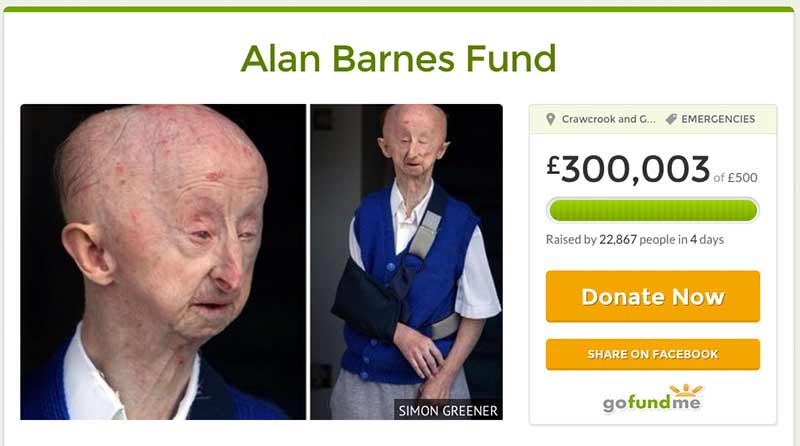Crowdfunding campaign for Alan Barnes tops £300k in four days
A crowdfunding campaign that aimed to raise £500 to help a disabled man who had been attacked outside his house has raised over £300,000 in four days.
Alan Barnes from Gateshead was knocked to the ground by his attacker who tried to rob him. He suffered a broken collarbone. He was so shocked by the attack that he did not want to return to living in his home, and hoped to find somewhere else to live.

The Alan Barnes Fund raises £300k in four days on GoFundMe.com.
Mr Barnes, 67, was born with sight and growth disabilities after his mother contracted German Measles during pregnancy.
The attack on a 4 ft 6″ disabled man was featured in national media included The Mirror. Hairdresser Katie Cutler, 21, who did not know Mr Barnes, was so affronted by the attack that she set up a fundraising campaign, the Alan Barnes Fund, to help him relocate, with the aim of raising £500. She used GoFundMe.com.
The appeal was shared online, and has been covered in many national and international media outlets.
The fund grew rapidly:
• after one day it had reached £50,000
• after two days it had raised £100,000
• on the morning of the third day it passed £200,000
• the £300,000 mark was reached just after 2pm today, the fourth day of the appeal
Donations were received not just from the UK but from people in other countries as far away as New Zealand.
Katie Cutler, also from Gateshead, has herself received praise from many of those donating to the fund.
What can fundraisers learn from the success of the Alan Barnes Fund campaign?
Once again a fundraising campaign has unexpectedly enjoyed rapid and remarkable growth. What can fundraisers surmise from this campaign?
1. It is unusual and not the norm. That is why it is attracting publicity, which is feeding the fund’s continued success. There are more and more examples of successful viral campaigns like #nomakeupselfie and #icebucketchallenge, but they are far from the norm.
2. The campaign was established by an individual and not a charity. In addition, this individual did not know Mr Barnes personally, but she did live locally. Can a personal appeal sometimes be more powerful than that of a charity?
3. Social media savvy or influence is not always a pre-requisite, but it becomes essential at some point in the campaign. Ms Cutler did not have significant social media follower numbers, but the national news sites that picked up the story certainly did.
4. The campaign focused on an individual, not a cause, or a group of people. There was a clear beneficiary.
5. The story that generated the giving evoked a sense of injustice in many of those who donated, according to many of the comments they posted on the campaign page. That was a powerful call to action, although of course there are current appeals that promise to address far bigger issues, helping many more individuals. So why did this story evoke such generosity?
6. The public understands that lots of small donations can have a big impact. Many donors commented that they could only give a small amount but were delighted to see so many others were giving too.
Advertisement



